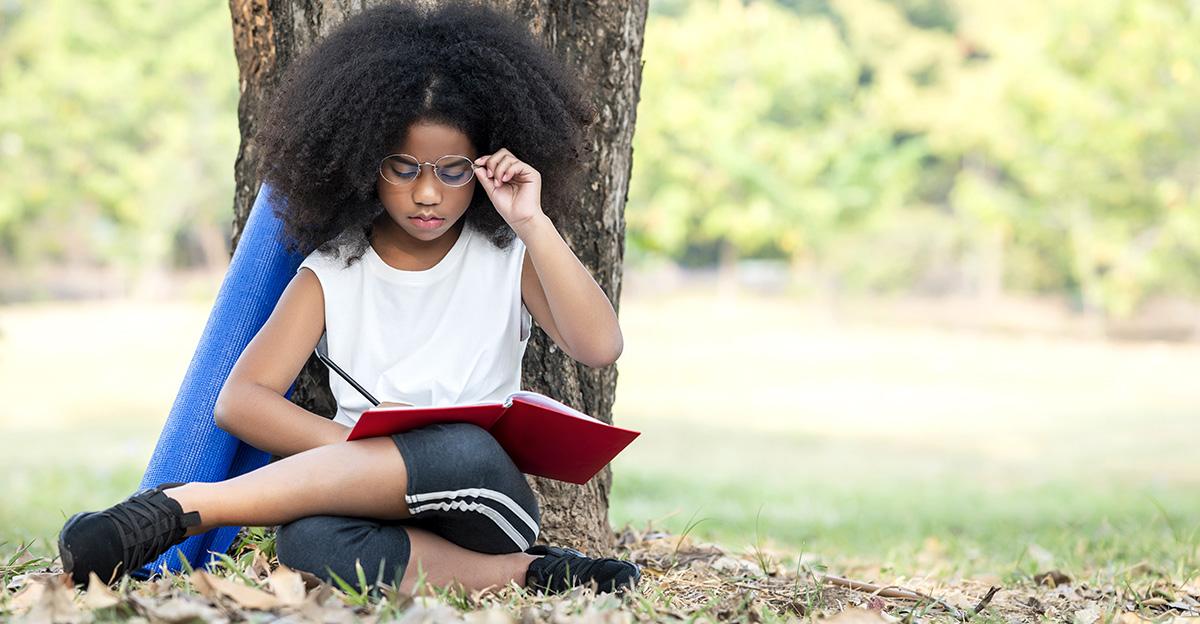When I began my teaching career in the late 1990s, moving instruction outside was a necessity during the warmer months. My southwest Michigan elementary school was not equipped with air conditioning, and hot, humid days in the classroom were unbearable. Fortunately, my classroom was at the end of a hall next to the door that accessed the playground. Moving instruction outdoors, whether it was planned or not, occurred frequently.
Reading instruction often took place on the grass under the large tree on the playground. During independent reading, students frequently brought out carpet squares or found a piece of playground equipment to read on. Science lessons integrated our school garden whenever possible, and our geometry and measurement units in math took advantage of shadows, playground equipment, and large open spaces to measure.
Integrate Outdoor Instruction & Technology
Of course, during the 90s, technology hardware was larger and not as mobile as today. In the early 2000s, I found myself an elementary principal in Virginia on a large property complete with a wooded nature trail bordering a picturesque farm. Our outdoor options were greater, and with increased utilization of the area, we added an outdoor classroom to maximize the space for instruction.
As technology changed and became portable, our project and investigation options increased. It was not unusual to see students creating movies with flip cams or iPads. I imagine today, those videos are even more robust as technology has progressed.
With so much emphasis and attention on electronic media, technology, and virtual connections, students today spend less time outdoors than any other generation. In addition, modern environments and communities have reduced the amount of open green spaces. Not only does this reduce exposure to fresh air and sunshine, but it also decreases physical activity that is needed by all.
Benefits of Outdoor Learning
Now more than ever, there is a renewed focus on outdoor education and the benefits of learning outside. Research has shown that interaction with nature—whether it be an outdoor learning classroom within a wooded area, open field, fenced-in patio, or edge of a playground—results in benefits for all involved. Students have shown improvements in focus, attention, memory, creativity, and critical thinking. In addition, the physical benefits of movement, vitamin D, and fresh air impact students and teachers alike. We all know that sometimes a change in environment can impact our mood and energy.
With the right mindset and supporting materials, classes can conduct traditional classroom activities outdoors. Reading, discussion, and reflection can all easily take place outside. If WiFi extends into the outdoor environment, students with mobile devices could do web-based inquiry and work on digital projects. Instructional activities can be as simple as independent reading, partner reading, creative writing, or small group instruction.
Ideally, instruction outdoors should be planned and purposeful. To get the most out of outdoor learning experiences, educators should consider how to take full advantage of being outside. Try to incorporate the setting itself into students’ learning. If students have access to fields, gardens, water, wooded areas, or other natural environments either on or adjacent to school grounds, educators can engage students in an inquiry-based exploration of these environments or create other hands-on learning opportunities.
Planning Outdoor Educational Activities
When planning for instruction outside, consider the goals of instruction, seating options, technology needs, how materials will be transported, how materials will be distributed, and how they will be cleaned afterward. A quick organizational strategy is carrying materials in plastic totes or bags for each student or small group lesson.
Here are six easy-to-implement outdoor instructional activities to inspire you:
- Read Outside: Assign time for students to grab a blanket, carpet square, portable seating, or yoga mat and read outside. Ideally, students will see that reading in different environments can impact their concentration or interest in what they are reading. Outdoor reading is also a great time for partner or buddy reading.
- Creative Writing: Task students with a creative writing topic, preferably one that encourages thinking about all of their senses.
- Scavenger Hunts: Younger students can search and identify items that begin with a certain letter or sound or share a trait or characteristic. Assign older students with rhymes or riddles to solve that require critical thinking skills.
- Following Maps and Directions: This is a great activity for students learning how to understand directions, measure distance, and navigation. Older students can create a map of the outdoor space to scale and identify key landmarks. Younger students may be provided a map of the outdoor space. In both cases, students are given directions and maps and challenged to reach a final location.
- Data Collection: Task students to collect data and graph information appropriately. This can include animals observed, types of plants and trees, trash collected in areas, or colors of plants in a planter box.
- Measurement and Estimation: Assign students to areas of the playground and have them measure the height of objects and estimate when needed. If possible, students can measure shadows and compare that to their measurement or estimation of the object itself.
The possibilities for outdoor learning are endless. With careful planning and slight modifications, most instructional activities can be moved to the outdoor setting, thus benefiting all involved!
Deanna Marie Lock
Deanna Marie Lock is a reputable educational leader with a multifaceted background as an elementary school teacher, assistant principal and principal, Instructional Solutions consultant, Instruction and Intervention Subject Matter Expert, and today as the Director of Category Expertise and Support across all of School Specialty’s target curriculum solutions and widespread product categories. With 18 years spent specifically in the public education sphere, Deanna now uses this in-classroom expertise to add a personalized, intentional approach when professionally advising to an audience she herself had been a part of for nearly two decades. Deanna is passionate about building purposeful long-term internal and external customer connections, and helping students find their passion and highest potential, too!







Leave a Reply